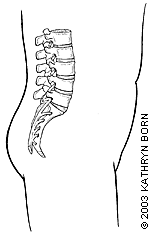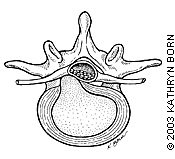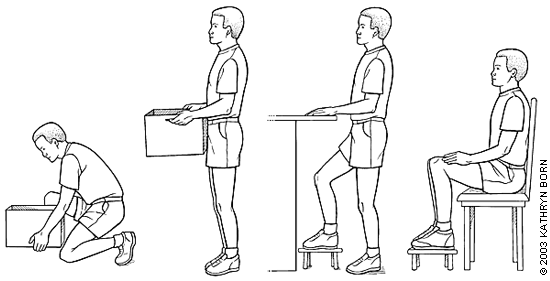
Am Fam Physician. 2003;67(10):2195-2196
What is a herniated disc?
When the soft part between the bones in the spine presses on the nerves around the backbone, it is called a herniated disc. The word “herniate” (say: her-nee-ate) means to bulge or to stick out. Sometimes this problem is called a ruptured disc.
Herniated discs are most common in the lumbar spine—the part of your backbone between the bottom of your ribs and your hips. Discs are soft “cushions” between the bones of the spine. Picture 1 shows part of the spine. The spine holds up your body. It also protects your spinal cord and nerves. The discs in the spine let you move your backbone.

Why does a disc get herniated?
As you grow older, your discs become flatter and less cushiony. If a disc becomes too weak, the outer part may tear. The inside part of the disc pushes through the tear and presses on the nerves beside it. Picture 2 shows how a disc looks when it pushed through the tear and presses on a nerve. Herniated discs are most common in people in their 30s and 40s.

What are the signs of a herniated disc?
When part of a disc presses on a nerve, it can cause pain in the back and the legs. The location of the pain depends on which disc is weak. How bad the pain is depends on how much of the disc is pressing on the nerve. In most people with herniated discs, the pain spreads over the buttocks and goes down the back of one thigh and into the calf. Some people have pain in both legs. Some people's legs or feet feel numb or tingly.
The pain from a herniated disc usually is worse when you are active and gets better when you are resting. Coughing, sneezing, sitting, driving, and bending forward may make the pain worse. The pain gets worse when you make these movements because there is more pressure on the nerve.
People with painful herniated discs often try to change positions to reduce the pain. You may have found that holding yourself up with your hands while you are sitting helps the pain. Shifting your weight to one side also may help.
How does my doctor know I have a herniated disc?
After asking you questions and giving you an exam, your doctor may take x-rays and other pictures to see if you have a herniated disc.
What can be done for the pain of a herniated disc?
Your doctor may suggest medicine for the pain. You can probably be more active after you have taken the pain medicine for two days. Becoming active will help you get better faster. If your pain is severe, your doctor may suggest that you rest in bed for a day or two.
If the pain medicine does not help, your doctor may give you a shot near your backbone. This might stop your pain. You may need more than one shot.
Sometimes stretching of the spine by your family doctor or a chiropractor can help the pain.
Will exercises help the pain?
Yes, exercises can be helpful. Begin by stretching. Bend over forward, and then bend to each side. Start these exercises after your back is a little stronger and does not hurt as much. The goal of exercise is to make your back and stomach muscles stronger. This will ease the pressure on your disc and make you hurt less. Ask your doctor about exercises for your back. Your doctor may want you to see a physical therapist to learn about safe back exercises.
What about my posture?
Good posture (standing up straight, sitting straight, lifting with your back straight) can help your back. Bend your knees and hips when you lift something, and keep your back straight. Hold an object close to your body when you carry it. If you stand for a long time, put one foot on a small stool or box for a while. If you sit for a long time, put your feet on a small stool so your knees are higher than your hips. Do not wear high-heeled shoes. Do not sleep on your stomach. These things can put more pressure on your discs. Picture 3 shows good posture in lifting, standing, and sitting.
What are my chances of getting better?
Your chances are good. Most people with a herniated disc are better in about four weeks. Sometimes it takes longer. If you still have pain or numbness after four to six weeks, or if your problem gets worse, talk with your doctor. Sometimes it takes surgery to relieve pain.
If you have trouble going to the bathroom or have weight loss, pain at night, or more pain or weakness than usual in backbone, tell your doctor right away. These might be the signs of a more serious problem.
